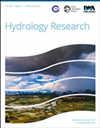HBV模型在中国北方人类影响流域的适用性
IF 2.4
4区 环境科学与生态学
Q2 Environmental Science
引用次数: 0
摘要
Hydroiska-Byrans-VattebalansavedeIning(HBV)模型是一种流域水文模型,已广泛应用于全球数百个流域。以地处半干旱气候区、受人类活动高度调控的南拒马河流域为例,探讨了HBV模型在该流域的适用性。结果表明:(1)由于环境变化,南拒马河记录流量呈显著下降趋势,径流量与降水量的关系也发生了变化,相关系数从1961~1979年自然期的0.58下降到2000~2018年高度调控期的0.01。(2) HBV模型在自然期的日和月出院模拟中表现良好,校准和验证期的Nash–Sutcliffe效率(NSE)系数分别为0.63和0.81。(3) 当南拒马河流域受到人类活动的中度和高度调节时,HBV模型的适用性将降低。中度扰动和强烈扰动阶段的日尺度NSE分别为0.42和-0.3,这意味着HBV模型几乎失去了捕捉高度调节集水区水文特征的能力。本文章由计算机程序翻译,如有差异,请以英文原文为准。
Applicability of the HBV model to a human-influenced catchment in northern China
The Hydrologiska Byrans VattenbalansavdeIning (HBV) model is a catchment hydrological model that has been widely applied to hundreds of catchments worldwide. Taking the Nanjuma River Basin which is located in a semi-arid climate zone and has been highly regulated by human activities, as a case, the applicability of the HBV model to the basin was investigated. Results show that (1) due to environmental change, recorded stream flow of the Nanjuma River presented a significant decreasing trend, and the relationship between runoff and precipitation was changed as well, with the correlation coefficient decreasing from 0.58 in the natural period of 1961–1979 to 0.01 in a highly regulated period of 2000–2018. (2) The HBV model performs well on daily and monthly discharge simulation for the natural period with the Nash–Sutcliffe efficiency (NSE) coefficients in calibration and validation periods of 0.63 and 0.81 for daily discharge simulation. (3) The HBV model's applicability would like to decrease when the Nanjuma River Basin was moderately and intensively regulated by human activities. The daily-scale NSEs in moderate-disturbance and intensive-disturbance phases are 0.42 and −0.3, which means the HBV model almost lost its capacity in capturing hydrological features for a highly regulated catchment.
求助全文
通过发布文献求助,成功后即可免费获取论文全文。
去求助
来源期刊

Hydrology Research
Environmental Science-Water Science and Technology
CiteScore
5.30
自引率
7.40%
发文量
70
审稿时长
17 weeks
期刊介绍:
Hydrology Research provides international coverage on all aspects of hydrology in its widest sense, and welcomes the submission of papers from across the subject. While emphasis is placed on studies of the hydrological cycle, the Journal also covers the physics and chemistry of water. Hydrology Research is intended to be a link between basic hydrological research and the practical application of scientific results within the broad field of water management.
 求助内容:
求助内容: 应助结果提醒方式:
应助结果提醒方式:


